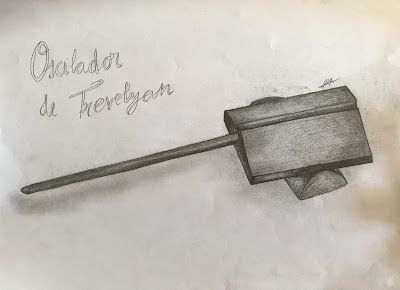Química
2º Bach (D)
2017/2018
IES "Pedro Espinosa"
Antequera (Málaga)
Debe su nombre a su inventor Arthur Trevelyan (1802-1878), que fue el primero en dar una explicación de este fenómeno.
Este aparato está constituido por una barra de bronce con una ranura, acabada en una varilla.
Calentando el bloque con un mechero y colocando este bloque sobre otro bloque frío, debido a la expansión del calor, comienza a vibrar emitiendo un sonido que se modifica presionando con una punta sobre el bloque.
Arthur Trevelyan decía que, a veces, es posible crear un sonido apoyando un cuerpo muy caliente sobre uno frío.
Para reproducir su experiencia, se puede utilizar una tabla de madera como soporte y se coloca un cubo con una lúnula de hierro también de madera y un prisma de plomo sobre la misma.
Sobre el cubo, se coloca el extremo correspondiente a la varilla del oscilador de Trevelyan, fabricado en latón, fijado por la lúnula y el otro extremo, correspondiente a un prisma con rendija, se apoya sobre el prima de plomo por la parte que tiene la ranura.
Calentando fuertemente la varilla de latón, se produce un sonido musical generado por la oscilación de los bordes de la ranura en el borde del prima de plomo. Puede ocurrir que con las irregularidades de los materiales, estos se dilaten en el punto de contacto rechazando la oscilación por lo que no sonaría. Estos dos procesos se irán alternando hasta que la plancha se haya enfriado lo suficiente para no realizar la oscilación.
Arthur Trevelyan (1802-1878) describió este dispositivo a la Royal Society de Edimburgo en 1829.
Este gran físico también fue un compositor de canciones, prueba de ello, se encuentra en la obra "The King of the Winds" cuya música estuvo a cargo de Frank David.
En la obra "The correspondence of Michael Faraday: 1849-1855", en la carta 2707 que Faraday recibió de John Tyndal, el 28 de julio de 1853, éste menciona que ha reproducido el experimento de Trevelyan con otros materiales.
NAME: TREVELYAN OSCILLATOR
DIMENSIONS (cm): 34
MATERIAL: BRONZE
DATING: EARLY 20th CENTURY
CALL NUMBER: A-04
ACOUSTICS-007
16.02.055
The name from this scientific instrument is after its inventor Arthur Trevelyan (1802-1878), who was the first person to give an explication of this phenomenon.
This device consists of a bronze bar with a groove, finished in a rod. Heating the block with a lighter and placing it on another cold block, due to the expansion of heat, it begins to vibrate emitting a sound that modified by pressing with a tip on the block.
Arthur Trevelyan said that sometimes it is possible to create a sound by resting a very hot body on top of a cold one.
To reproduce their experience, a wooden board can used as a support and a cube with an iron lune also made of wood and a lead prism are placed on it.
On the cube, the end corresponding to the rod of the Trevelyan oscillator placed, made of brass, fixed by the lune and the other end, corresponding to a prism with a slit, rests on the lead premium for the part that has the groove.
By strongly heating the brass rod, a musical sound produced generated by the oscillation of the edges of the groove at the edge of the lead premium. It may happen that with the irregularities of the materials, they dilate at the point of contact rejecting the oscillation so it would not sound. These two processes will alternate until the plate has cooled enough not to make the oscillation.
Arthur Trevelyan (1802-1878) described this device to the Royal Society of Edinburgh in 1829.
This great physicist was also a songwriter, proof of this, founded in the work "The King of the Winds" whose music was in charge of Frank David.
In the work "The correspondence of Michael Faraday: 1849-1855", in the letter 2707 that Faraday received from John Tyndal, on July 28, 1853, he mentions that he has reproduced Trevelyan's experiment with other materials.
José Castillo Pérez
Inglés
1º Bach. (B)
Curso 2021/2022
IES "Pedro Espinosa"
Antequera (Málaga)
REFERENCIA: ERNST LEYBOLD NACHFOLGER Nº 1921.




No hay comentarios:
Publicar un comentario